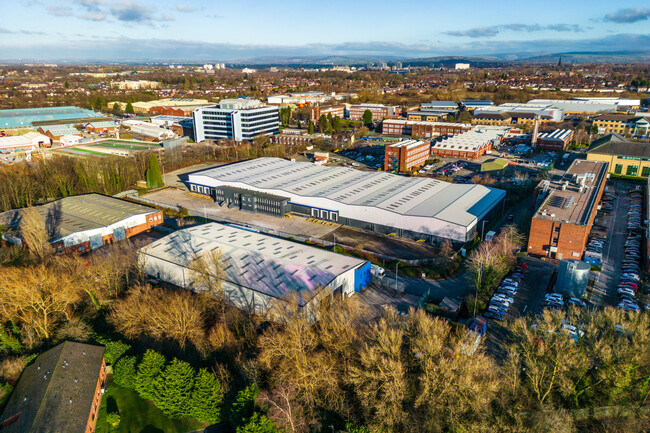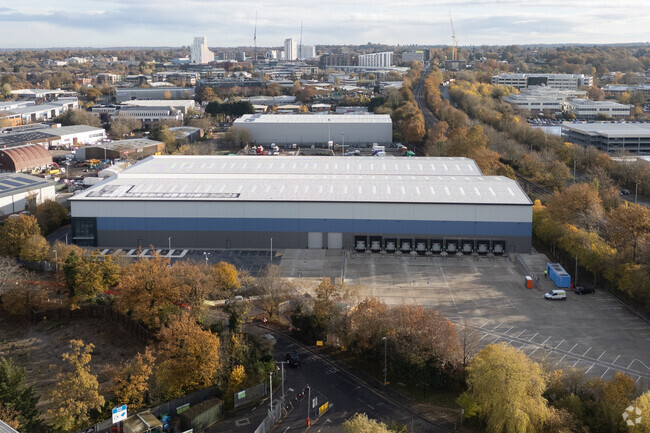Industrial Units & Warehouses to Rent in the UK
Industrial Units and Warehouses to Rent in the UK
- Warehouse Management System (WMS): Essential for efficient inventory management, tracking stock levels, managing order fulfillment, and optimizing storage space.
- Automation and Robotics: Utilized for tasks like picking, packing, and stacking, increasing speed and accuracy with the help of AGVs and robotic arms.
- High-Density Storage: Maximizes space utilization through solutions like AS/RS and vertical carousels.
- RFID Technology: Enables real-time tracking of inventory, assets, and shipments, improving accuracy and reducing errors.
- Barcode Scanning: Used for item identification, order picking, and inventory tracking, integrating with WMS to streamline operations.
- IoT Sensors: Monitor temperature, humidity, and environmental conditions to ensure the quality and safety of stored goods.
- Cloud-Based Software: Provides remote access to warehouse data and management tools, offering real-time visibility and control.
- Material Handling Equipment: Includes conveyor systems, forklifts with RFID scanners, and automated guided carts for efficient movement of goods.
- Energy-Efficient Lighting: Utilizes LED lighting for energy savings, cost reduction, and improved visibility.
- Warehouse Control System (WCS): Coordinates material and goods movement, optimizing traffic flow and reducing congestion.
- Voice and Pick-to-Light Systems: Enhance accuracy and speed in order fulfillment through voice-directed picking and pick-to-light systems.
- Predictive Maintenance: Uses sensors and data analytics to predict equipment maintenance needs, reducing downtime and improving reliability.
- Security Systems: Incorporates surveillance cameras, access control, and intrusion detection to protect goods and prevent theft.
- Smart Shelving and Racking: Adjustable, smart systems enable flexible storage configurations and adaptability to changing inventory needs.
- Drones and UAVs: In some cases, used for tasks like inventory counting and monitoring large warehouse spaces.
- Telematics and Fleet Management: Tracks vehicle locations, fuel usage, and driver behavior for efficient fleet management.
- Energy Management: Optimizes HVAC and lighting systems for energy savings and sustainability.
- Data Analytics and Reporting: Provides insights into warehouse performance, optimizing processes and decision-making.
- Green and Sustainable Features: Incorporates elements like solar panels, rainwater harvesting, and eco-friendly materials.
- Emergency Response Systems: Includes fire detection and suppression, along with emergency exit plans and safety equipment.
- London and Southeast England:
London is a major logistics and distribution hub due to its proximity to the Port of London, Heathrow, and Gatwick airports. The Southeast region offers connectivity to the M25 motorway, providing access to the entire country.
- East Midlands:
The East Midlands, including cities like Nottingham, Derby, and Leicester, boasts a central location in the UK with excellent transport links. It's well-connected to major road networks, particularly the M1, and has access to East Midlands Airport.
- West Midlands:
The West Midlands, centered around Birmingham, benefits from its proximity to the M6 motorway, the UK's busiest. Birmingham Airport and the Port of Birmingham offer additional transportation options.
- North West England:
Cities like Manchester and Liverpool serve as key logistics centers in the North West. They enjoy proximity to the Port of Liverpool, Manchester Airport, and easy access to the M62 and M56 motorways.
- South Yorkshire, West Yorkshire and the Humber:
This region, including cities like Leeds, Sheffield, and Hull, offers easy access to major motorways, such as the M62 and M1. Ports like Hull and Immingham provide access to sea transportation.
- Southampton and the South Coast:
Southampton is a significant port city on the South Coast, making it ideal for warehousing related to maritime trade. It has excellent road and rail connections and is served by airports like Southampton and Bournemouth.
- Glasgow and Central Scotland:
Glasgow is a key transportation hub in Scotland, with access to the M8 motorway and proximity to ports like Grangemouth. Edinburgh Airport is also within reach.
- Northern Ireland:
Belfast, in Northern Ireland, is strategically positioned for warehousing serving both the UK and Ireland. It benefits from Belfast Harbor and access to the M1 motorway.
- Wales:
Locations in South Wales, including Cardiff and Newport, are well-connected to the M4 motorway and enjoy proximity to ports like Cardiff Docks.
- North East England:
Cities like Newcastle and Sunderland have access to major roads such as the A1 and A19 and are well-placed for distribution to the North of England and Scotland.






























































